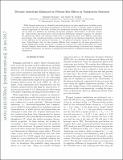| dc.contributor.author | Romano, Giuseppe | |
| dc.contributor.author | Kolpak, Alexie M. | |
| dc.date.accessioned | 2018-11-02T17:34:42Z | |
| dc.date.available | 2018-11-02T17:34:42Z | |
| dc.date.issued | 2017-02 | |
| dc.date.submitted | 2016-10 | |
| dc.identifier.issn | 0003-6951 | |
| dc.identifier.issn | 1077-3118 | |
| dc.identifier.uri | http://hdl.handle.net/1721.1/118842 | |
| dc.description.abstract | While thermal anisotropy is a desirable materials property for many applications, including transverse thermoelectrics and thermal management in electronic devices, it remains elusive in practical natural compounds. In this work, we show how nanoporous materials with anisotropic pore lattices can be used as a platform for inducing strong heat transport directionality in isotropic materials. Using density functional theory and the phonon Boltzmann transport equation, we calculate the phonon-size effects and thermal conductivity of nanoporous silicon with different anisotropic pore lattices. Our calculations predict a strong directionality in the thermal conductivity, dictated by the difference in the pore-pore distances, i.e., the phonon bottleneck, along the two Cartesian axes. Using Fourier's law, we also compute the diffusive heat transport for the same geometries obtaining significantly smaller anisotropy, revealing the crucial role of phonon-size effects in tuning thermal transport directionality. Besides enhancing our understanding of nanoscale heat transport, our results demonstrate the promise of nanoporous materials for modulating anisotropy in thermal conductivity. | en_US |
| dc.publisher | AIP Publishing | en_US |
| dc.relation.isversionof | http://dx.doi.org/10.1063/1.4976540 | en_US |
| dc.rights | Creative Commons Attribution-Noncommercial-Share Alike | en_US |
| dc.rights.uri | http://creativecommons.org/licenses/by-nc-sa/4.0/ | en_US |
| dc.source | arXiv | en_US |
| dc.title | Thermal anisotropy enhanced by phonon size effects in nanoporous materials | en_US |
| dc.type | Article | en_US |
| dc.identifier.citation | Romano, Giuseppe and Alexie M. Kolpak. “Thermal Anisotropy Enhanced by Phonon Size Effects in Nanoporous Materials.” Applied Physics Letters 110, 9 (February 2017): 093104 © 2017 Author(s) | en_US |
| dc.contributor.department | Massachusetts Institute of Technology. Department of Mechanical Engineering | en_US |
| dc.contributor.mitauthor | Romano, Giuseppe | |
| dc.contributor.mitauthor | Kolpak, Alexie M. | |
| dc.relation.journal | Applied Physics Letters | en_US |
| dc.eprint.version | Original manuscript | en_US |
| dc.type.uri | http://purl.org/eprint/type/JournalArticle | en_US |
| eprint.status | http://purl.org/eprint/status/NonPeerReviewed | en_US |
| dc.date.updated | 2018-10-17T13:45:37Z | |
| dspace.orderedauthors | Romano, Giuseppe; Kolpak, Alexie M. | en_US |
| dspace.embargo.terms | N | en_US |
| dc.identifier.orcid | https://orcid.org/0000-0003-0026-8237 | |
| dc.identifier.orcid | https://orcid.org/0000-0002-4347-0139 | |
| mit.license | OPEN_ACCESS_POLICY | en_US |
